The Census of Philippine Business and Industry (CPBI) is one of the designated statistical activities of the Philippine Statistics Authority (PSA), undertaken every five years, which aims to collect and generate information on the levels, structure, performance and trends of economic activities of the formal sector of the economy. The results of the CPBI serve as benchmark information in the measurement of national and regional economic growth. The 2018 CPBI is the 16th of the series of economic censuses in the country.
This Special Release covers the performance of the Agriculture, Forestry, and Fishing sector which includes the ten industry groups covering the activities on animal production, comprising the activities of growing crops, silviculture and other forestry activities. This section also includes support activities to agriculture and post-harvest activities.
Agriculture sector grows by 34% in 2018
- The results of the 2018 Census of Philippine Business and Industry (CPBI) showed that a total of 3,285 establishments were engaged in agriculture, forestry, and fishing (AFF). This was 33.5 percent increase from the 2,461 recorded establishments in 2012.
-
Animal production with 1,953 establishments which accounted for the largest percent share (48.5%) of the total agriculture, forestry, and fishing industry establishments in the country. Growing of non-perennial crops followed with 500 establishments and support activities to agriculture and post-harvest crop activities with 413 establishments.
-
Among the establishments engaged in agriculture, forestry, and fishing (AFF) in the Philippines, Central Luzon had the most share with 17.8% of the total AFF establishments, followed by Davao Region and CALABARZON with 11.3% and 11.1% shares, respectively. On the other hand, the Cordillera Administrative Region had the least number of establishments engaged in agriculture, forestry, and fishing with 1.2% share of the total AFF industry.
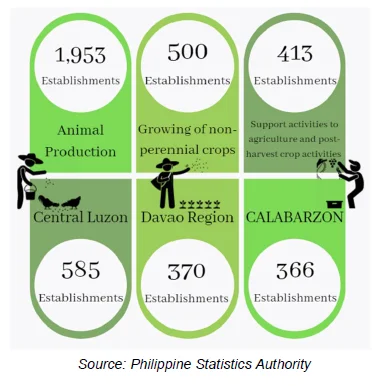
CAR’s AFF industry expands by 200% in 2018
- The 2018 CPBI showed that there is a total of 39 establishments engaged in agriculture, forestry, and fishing industry in the region. This is 200 percent more than the 13 recorded establishments in 2012.
- The greatest contributor to the number of establishments in the Cordillera Administrative Region are the animal production and support activities to agriculture and post-harvest crop activities both with 15 establishments, respectively.
Establishments engaged in growing of perennial crops employ most workers
- Workers engaged in agriculture, forestry, and fishing industry activities decreased by 6.0 percent from 164,706 in 2012 to 154,910 employees in 2018. Growing of perennial crops generated the most employment accounting for 38.5 percent (59,644 workers) of the total industry employment.
-
Animal production with 37,618 employees (24.3%) and growing of nonperennial crops with 25,351 employees (16.4%) ranked second and third, respectively. On the other hand, logging had the least contribution to agriculture, forestry, fishing (AFF) employment with 19 employees or a 0.01 percent share.
-
The Davao Region had the most employees engaged in agriculture, forestry, and fishing industry with 40,641 employees or 26.2 percent of the totalemployment in the industry. This is followed by the Western Visayas with 19,118 (12.3%), and Northern Mindanao with 19,105 (12.3%). Meanwhile, Cordillera Administrative Region recorded a 0.19 percent share to the total employment in the industry.
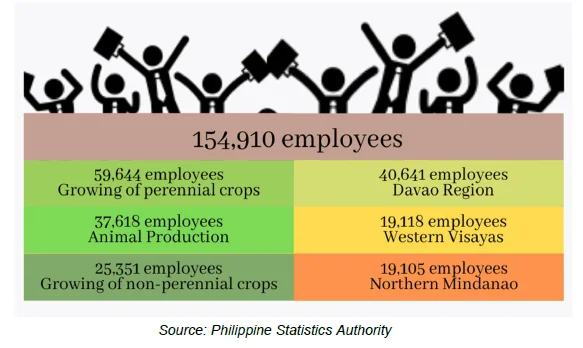
Compensation expenses of AFF industry at PhP 27.0 billion
- The agriculture sector spent a total of PhP 27.0 billion to compensate its 152,519 paid employees in 2018. From this, it can be said that a worker from the agriculture, forestry, and fishing (AFF) industry earned an average annual income of PhP 176,892.
-
Establishments engaged in the growing of perennial crops spent the most in paying its workers at PhP 11,160,162 billion. This was followed by animal production establishments (PhP 6,261,174 billion), support activities to agriculture and postharvest crop activities (PhP 3,105,505 billion), and growing of non-perennial crops (PhP 2,799,393 billion).
-
At the regional level, National Capital Region (NCR) recorded the highest average annual compensation per paid employee at PhP 390,311. Aside from NCR, six other regions (Cagayan Valley, Central Luzon, CALABARZON, DAVAO, SOCCSKSARGEN, ARMM) recorded average annual compensation more than the national level figure. In CAR, a total of PhP 17.5 million was disbursed to the agriculture industry employees in 2018. This led to a per capita average annual compensation of PhP 73,151.
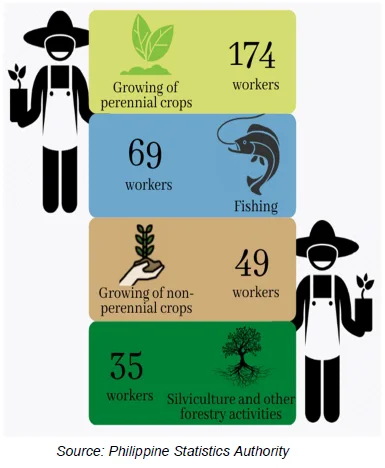
Income of AFF establishments up by 50%
- Agriculture, forestry, and fishing industries generated a total revenue of PhP 207.0 billion in 2018, a 50.0 percent increase from the PhP 138.0 billionrevenue of the sector in 2012.
-
Majority of the total national income of agriculture, forestry, and fishing establishments were from Davao Region with PhP 49.3 billion or 23.8 percent share. Entities from Central Luzon generated the second-most revenue in the country with PhP 48.9 billion or 23.6 percent share.
-
Animal production industry contributed the highest income to the total national income with PhP 99.7 billion. Income from growing of perennial crops came next with PhP 59.1 billion. The top industry income-earners were also the main contributors to the sector’s expenses: animal production spent PhP 87.8 billion (45.2 percent) and growing of perennial crops with PhP 52.7 billion (27.1 percent).
-
Expenditures of agriculture, forestry, and fishing entities reached PhP 194.3 billion in 2018, a 38.1 percent increase from 2012’s costs of PhP 140.7 billion. The amount spent for the compensation of employees only comprised 13.9 percent of the sector’s total spending.
-
The top region income-earners in agriculture, forestry, and fishing industry were also the main contributors to the sector’s expenses: Davao Region spent PhP 41.7 billion (21.5 percent) and Central Luzon with PhP 41.4 billion (21.3 percent).
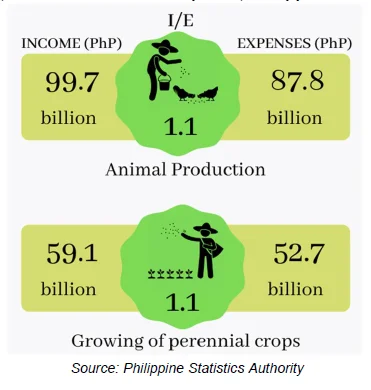
- Growing of perennial crops and silviculture and other forestry activities both recorded the greatest gain with an income per expense ratio of 1.3. On the other hand, support activities to agriculture and post-harvest crop activities incurred the least income per expense ratio of 0.4 in 2018. Logging had the second least I/E ratio of 0.7.
CAR revenue per expense ratio at 1.3, higher than the national level
- In CAR, animal production, growing of non-perennial crops, and support activities to agriculture and postharvest crop activities recorded the most revenues in 2018 with PhP 167.9 million, PhP 24.4 million, and PhP 9.4 million, respectively.
-
Expenditures of agriculture, forestry, and fishing entities in CAR reached PhP 167.6 million in 2018. The top industry income-earners in CAR were also the main contributors to the region’s expenses: animal production spent PhP 137.7 million (82.2 percent), growing of nonperennial crops with PhP 17.1 million (10.2 percent), and support activities to agriculture and post-harvest crop activities with PhP 5.6 million (3.33 percent).
Annual Income and Expense, CAR:2018

- Value added generated by all agriculture, forestry, and fishing establishments in 2018 reached PhP 56.4 billion, grew by 75.7 percent from PhP 32.1 billion produced in 2012.
-
Industry-wise, animal production contributed the highest value added with PhP 23.5 billion or 41.7 percent share to the total output of the sector. This was followed by growing of perennial crops with PhP 19.5 billion (34.6 percent) growing of non-perennial crops with PhP 7.4 billion (13.2 percent).
-
Across regions, Davao registered the highest value added of PhP 18.5 billion 932.8 percent), followed by Central Luzon and Northern Mindanao with PhP 13.9 billion (24.6 percent) and PhP 7.3 billion (12.9 percent), respectively. CAR establishments engaged in the agriculture, forestry, and fishery sector reported a value-added total to PhP 77.6 million.
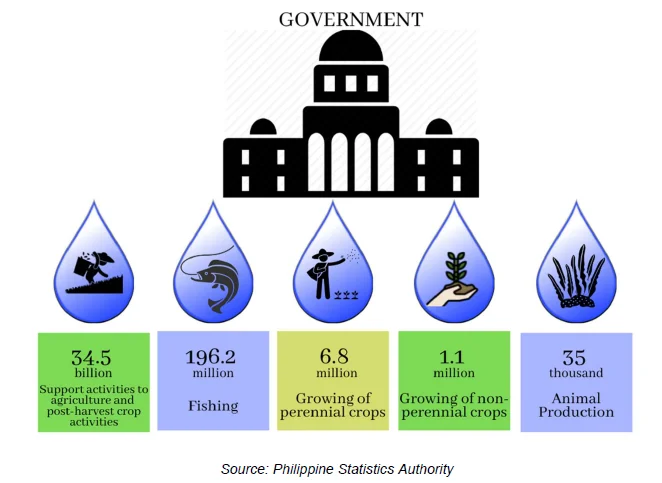
- The total subsidies received by the agriculture, forestry, and fishing sector amounted to PhP 34.9 billion in 2018. This was 869.4 percent higher than the PhP 3.6 billion worth of subsidies granted by the government in 2012.
-
Support activities to agriculture and post-harvest crop activities (PhP 34.5 billion), fishing (PhP 196.2 million), growing of perennial crops (PhP 6.8 million), growing of non-perennial crops (PhP 1.1 million), aquaculture (PhP 75 thousand), and animal production (PhP 35 thousand) comprise the industries that received subsidies from the government in 2018.

